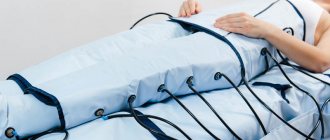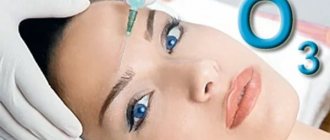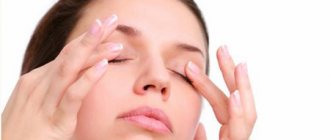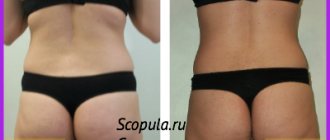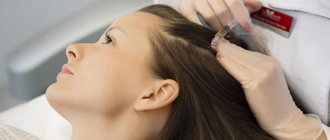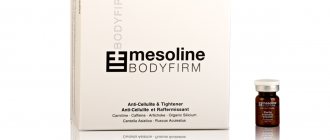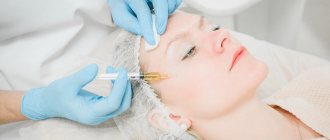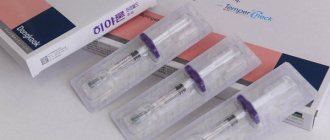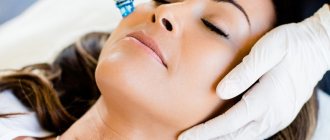Electrolysis is based on the properties of electric current, which can negatively affect the hair roots. Electrical energy is directed to the area of direct hair growth. Modern devices allow you to act in a targeted, precise and safe manner. For this, a special needle or metal thread is used.
To stop hair growth, the follicles are destroyed by electric current. An electrical impulse travels through a thin electrode directly into the follicle, destroying the hair follicle. Destruction is ensured by high temperature. It affects the lower area of the follicles. This ensures complete cessation of hair growth. The follicles literally melt, but for the full effect you will need to undergo several sessions.
Hair of any shade, type and thickness is destroyed. Important condition: hair must be no shorter than 2 mm.
Hair removal using electric current has become widespread and has been successfully used in cosmetology for more than 80 years. At first the procedure was very expensive, but now it is available to every woman.
Types of electrolysis
Different types of electrodes can be inserted. The following methods of electric hair removal are distinguished:
- Tweezer : The electrode is shaped like tweezers. It is through it that the current passes. During the procedure, only one hair is captured. The method has low pain, therefore it is often used in particularly sensitive areas (bikini, mustache). Among the disadvantages of the method is that it takes at least two minutes to remove each hair, so it is not used to combat thick hair.
- Needle-shaped : the name refers to the shape of the electrodes. They are extremely thin, about 0.1 mm in diameter. These needles are made from different metals. They can be curved or straight in shape.
The needle method has its advantages:
- Teflon-insulated needles are used for areas of high pain sensitivity. They do not cause burns.
- Gold-plated needles are used if the patient has allergies.
Needle electrolysis has a number of types:
- Galvanic electrolysis : the bulbs are actively affected by galvanic (direct) current. Because of this, caustic alkali quickly accumulates in them. At the end of the procedure, the damaged hair and bulb are removed. During electrolysis, the patient does not experience much pain, but the procedure itself is quite slow.
- Thermolysis : AC current is used. The procedure is painful, so injections are used for pain relief. In addition, thermolysis can cause burns, so it is not used on the face.
- Sequential blend : This is a variation of the blend method, but uses a low pulse current. This reduces pain.
- Blend method : this name is associated with the English term “bland”, which means the mixing process. In this case, the hair is first heated using the thermolysis method, and then the hair follicle is destroyed using electrolysis. The most modern blend epilators are now used. They allow you to individually select the strength of the impact and the frequency of the current.
- Flash Method : The name refers to the English word meaning "flash". This is the most advanced type of thermolysis, which uses high-frequency current. Pain and injury are minimal.
- Sequential flush : the most modern flash method. In this case, a sinusoidal current of the highest frequency is used, which guarantees speed and maneuverability.
Needles
Needles are used to perform bikini electrolysis. They come in three types:
- needles made of nickel-chrome alloy, used in women with a low pain threshold;
- Teflon-coated needles significantly reduce pain;
- golden needles are used in women prone to allergic reactions.
Contraindications and consequences of electrolysis
This technique has a yard of limitations. Contraindications:
- Heart and vascular diseases, in particular previous heart attack, stroke.
- Skin inflammation.
- Endocrine diseases.
- Tumors of any kind.
- Pregnancy, breastfeeding.
- Epilepsy and all kinds of mental pathologies.
- Metal intolerance.
- Varicose veins (in this case, you need to use a different method to remove hair from your legs).
- You should not do the procedure during your period.
The consequences of the procedure are minimized if you trust an experienced cosmetologist and use high-quality modern equipment.
Possible consequences:
- If you miscalculate the current strength, scars may appear. It is also very important not to neglect caring for the treated area after the procedure.
- Often small red spots remain on the skin. These marks disappear after a couple of weeks.
- Itching in the epilation area. This is unpleasant, but considered normal. The main thing is not to scratch, otherwise you can scratch the skin until there is blood and subsequent scars.
- An infection may enter the epidermis.
Injection anesthesia (injections).
Used for pain relief: small areas of the body where sensitivity is especially high:- pubis;
- armpits;
- deep bikini;
- intergluteal zone;
- anus;
- phalanges of toes/hands;
- face: mustache, nasolabial fold, eyebrows;
Injection anesthesia is performed on site by a specialist in the form of subcutaneous injections. Completely relieves pain within 1-2 minutes (you can work right away). Total pain relief (sensitivity disappears completely).
Advantages and disadvantages of electrolysis
Advantages:
- Complete, final destruction of the follicles. This means that the hair will never appear again.
- You can destroy any type of hair, in almost any area.
- The procedure is available at any age. It doesn't matter how thick your hair is or what condition it is in.
- Neither skin sensitivity, tanning, nor hair color will interfere with electrolysis.
- Compared to other modern types of hair removal, this procedure remains relatively inexpensive.
The disadvantages are the following:
- The procedure is quite expensive. The final cost depends on the set of needles used.
- Soreness.
- There is a risk of infection.
- The session takes quite a long time.
Skin preparation
The answer to the question of how to properly prepare for electrolysis is closely related to your skin type. The preparation is slightly different for different types.
- If you have dry skin, then the day before electrolysis, do a light peeling of those areas of the body where you plan to remove hair. Apply cream for dry skin. This is necessary in order to remove dry scales that interfere with hair removal.
- If your skin is oily, you should clean it the day before hair removal using lotion or another product.
- For those with normal skin, it is enough to take a warm shower before the procedure.
To keep your skin well hydrated, drink more water and juices, but drink coffee, tea and alcoholic drinks in limited quantities.
Can electrolysis be done at home?
Devices for home electrical hair removal are now available for sale. In advertising we are convinced that they are effective and at the same time safe. Experts warn that such devices have low power. Most likely, they will not cope with the assigned task or will only remove thin hairs. In addition, only a specialist will be able to accurately select the power of the electrical impulse and ensure proper skin care after the procedure.
Undoubtedly, it is better to give preference to professional equipment rather than household “toys”.
A little history
Electric hair removal in cosmetology is rightly considered the oldest method of getting rid of hair. It was discovered in 1875 by American ophthalmologist Charles Michel (1833-1913) and was used to remove ingrown eyelashes. But after 5 years, this method began to be used for cosmetic purposes. In the middle of the last century, the first device for electrolysis was patented. And soon the procedure became very popular in America and England, and in the 70s they began to study it as a subject in medical institutions.
How is electric hair removal performed?
The procedure at home and in the salon is practically no different. The principle of influence remains the same. The only difference is that the doctor has experience, and you do not. Therefore, the home result may not live up to expectations. In addition, devices for home use have very low power compared to professional salon devices.
Electrolysis in the salon proceeds according to the following algorithm:
- If necessary, anesthesia is performed. It is most often local. Sometimes a painkiller tablet is taken. The anesthetic is selected depending on the treatment area, hair type, and type of electrolysis.
- A very thin needle is very carefully inserted into the follicle, along the surface of which a current is applied. Experts recommend tungsten filament. It practically does not cause burns.
- The needle or thread is held until the hair follicle is destroyed.
- The hair is removed with tweezers.
The duration of the procedure is from 30 minutes to 1.5 hours.
The home procedure is as follows:
- Half an hour before the procedure, the hair removal area is treated with an ointment or solution with an anesthetic.
- One by one, a needle is inserted into the hair follicles and current is passed through it.
- After the procedure, the treatment area is disinfected.
Since electrolysis is not such a simple cosmetic procedure, you should not do it yourself at home. You may lack dexterity and experience. It is better to entrust your beauty to a professional.
Anesthesia
In some cases, medications such as Ibuprofen or Tempalgin help reduce pain. They should be taken 30-60 minutes before the start of the procedure. There are situations in which the use of painkillers is inevitable. First of all, it depends on the level of sensitivity to electric current, and secondly, on the area being epilated. Most often, injections are given in the armpits and bikini area; legs and arms are always given without injections, because these areas are very large and the amount of anesthesia would exceed all permissible standards. In such cases, special ointments and creams are used, but they are more than enough if the pain threshold is very high.
The most famous are Emla, Light Dep creams and the well-proven Hungarian-made Lidocaine spray. All these products are generously applied to the skin 60 minutes before electrolysis under an occlusive dressing, which is most often used as ordinary cling film. It should be well fixed; for this you can use patches or tight underwear to tightly fit the film in the bikini area. The use of the cream is acceptable before injections when they are unbearably painful.
How many sessions are needed?
Don't expect to get the desired effect the first time. You can only remove those hairs that are actively growing. But dormant bulbs will remain untouched. To achieve the desired effect, the procedure must be repeated 5-10 times . A third of the hair will disappear immediately.
The essence of the procedure
To carry out proper preparation, you need to imagine how the procedure takes place. Electrolysis involves applying an electric current to the visible part of the hair and through it to the follicle. As a result, the follicle dies and hair growth stops forever. Since at any given time some part of the hair is in a dormant state or is very small in size, it will not be possible to completely get rid of unwanted hair on the body in one session.
The result of the procedure largely depends on the skill and conscientiousness of the specialist, so carefully choose the salon where you will perform hair removal and the specialist.
Skin care after electrolysis
To avoid unwanted consequences, it is important to provide proper care.
- The skin is processed for disinfection. Regular alcohol or chlorhexidine will do. At home, you can re-treat the area with a solution of calendula or trichopolum.
- Washing and bathing are contraindicated for 24 hours.
- You cannot use deodorants and creams for two days.
- For a week you will have to forget about the sauna, your favorite bathhouse, swimming pool or your usual gym.
- Do not sunbathe or use self-tanner for two weeks.
Other sprays don't work.
The order is as follows:
Go to the bathroom/restroom. The skin should be as warm as possible (so that the pores are open and the anesthetic can penetrate faster and to a greater depth). If your skin is cold, warm it under warm water. It is advisable to rub the treated area with a hard washcloth/scrub (to remove dead cells - again for better absorption of the anesthetic into the skin). Next, apply generously either:
- lidocaine - spray (be sure to close your airways with a mask/insert cotton wool pads into your nose so as not to breathe in when applying) right before the flow. Don’t skimp – if you apply little, the effect will be weak or not at all;
- lidocaine cream/gel - a uniform layer of approximately 1 mm over the entire surface where the procedure is supposed to be carried out, like this:
Also, do not save too much cream/gel; if the layer is insufficient, the sensitivity will remain high;
Next, wrap tightly with cling film (the first layer is simply imprinted/glued onto the anesthetic). Try as much as possible to avoid access of air under the film - it is enough to wrap 2 layers so that the film lays with a margin beyond the area covered with anesthetic (reserve for slipping, sliding of the film when walking/moving). You can secure the edges of the film with masking tape/adhesive tape to prevent it from slipping. There are also special anesthetic patches on sale. When you arrive for the procedure in this form, the master himself gradually turns you around.
